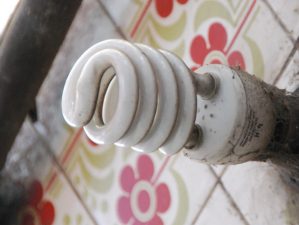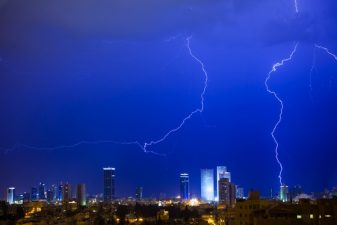
Like Tel Aviv and Beirut, Gaza’s getting a boardwalk, but development threatens ancient Roman ruins.
For years, it was a dusty, often garbage-strewn asphalt ribbon winding along Gaza City’s otherwise beautiful Mediterranean coast. Today, it’s a construction site, with heavy equipment plowing sand into position, digging tunnels and laying pipes.
But if the plans proceed on schedule, Al-Rashid Road, popularly known as the Beach Road, will be transformed into a scenic seaside promenade, or corniche, in the style that has made the meeting between land and sea in places like Beirut, Alexandria and Nice tourist attractions and a gathering place for their residents.
That prospect has brought smiles to everyone from beachgoers to property owners, who are looking forward to seeing the value of their land rise. But not everyone is happy. Many have been displaced by the construction and complain they haven’t been adequately compensated. Archeologists say the building indirectly threatens to destroy Gaza’s irreplaceable heritage.
The fact that the authorities can even contemplate a project like the corniche says a lot about how much Gaza has recovered economically in the past three years. Israeli trade sanctions that remain include construction materials like cement, but thanks to large-scale smuggling through tunnels under the border with Egypt, Gaza’s government can move ahead with concrete-heavy projects like the corniche.
The United Nations estimates that in September alone some 90,000 tons of cement came through the tunnels, nearly 10 times as much as through the Israeli border.
Sami Abu Hamdah, one of the project supervisors, talks enthusiastically about the corniche and its surrounding infrastructure, which will cut a swathe of 40 meters (130 feet) over two kilometers (1.2 miles), as well as plans to extend it deeper into the city in the next phase.
The narrow asphalt strip will be widened to a grand boulevard helping to ease the traffic congestion. Sidewalks along both sides of the street will be widened and a seafront promenade 11 meters across will run along the length of the beach. Parking areas are being built for visitors as well as a series of tunnels that will deliver beachgoers to the seashore away from the noise and cars of the street.
Mugani says that negotiations are under way with the electric company to bury the power lines that now obstruct the Mediterranean view. Trees and shrubbery, watered by an automated irrigation system, will take their place. Meanwhile, the Coastal Municipalities Water Utility (CMWU) is extending water and sewage pipes in a $20 million project funded by the German Bank of Development.
Once this phase is done, says Mugani, officials have ambitious plans to turn large parts of the city side of Beach Road into parks and gardens that will encourage tourism projects in Gaza.
But widening the road and adding new attractions has to come at a cost, and Abu Mahmoud Al-Ara’ir is one of the people paying it.
More than a decade ago he squatted on a piece of shorefront property, building a small house out of simple materials and fencing off the area around it with pieces of plastic and wood. The fence has come down as Abu Mahmoud is undertaking a strategic retreat in the face of warnings from the city to surrender all his property.
“After all, I don’t own this land and the municipality isn’t even obliged to compensate me according to the law,” he told The Media Line. “But the fact that I have been living here for the past 11 years makes me the owner, I think, even if I don’t have ownership papers or actually paid for it.”
Not all of the area’s residents are taking their loss with such equanimity. While the beachfront would normally be desirable real estate, many of those living in the area are poor.
Interviewed by The Media Line, many expressed the view that they should be entitled to squatters’ rights and that even if the authorities compensate them with other land, they don’t have the money to build themselves new homes on it. “Don’t we have the right to accept or refuse or even choose the location or compensation? Why can’t they just leave us alone and do this project somewhere else?” asks one.
Gaza’s municipal government is not sympathetic. In a statement issued in response to the complaints of angry beachfront residents, it said: “Ninety percent of these ‘owners’ don’t actually own their land. They took it and built simple houses on it over the last 10 years. The governments left them there because they had no place to live and the lands weren’t needed. So we aren’t obliged to offer compensation.”
The authorities said that any compensation, either cash or land in the Beach refugee camp, is entirely voluntary on their part. Pal-Tel Development, which won the $3.5 million contract to build the corniche, says it is the city’s responsibility to deal with residents.
As if these feuds aren’t enough, the Tourism and Antiques Ministry in Gaza has come out against the plan to give displaced residents land in the Beach Camp, saying they have archeological remains of an ancient port from the Roman era.
“These lands are the location of very important archeological sites. Excavations were conducted on this site from 1995 till 2005 by the French School of Antiques and Excavation,” says Hayam Al-Bittar, the head of the ministry’s museums department. “We should be doing our best to protect this site, not to offer it as compensation for people to build on it who don’t appreciate their heritage and history.”
She has vowed to file a complaint to the cabinet and, if all else fails, will resign from her position. “Not on my watch,” Hayam warns. “We will not rest until we ensure the safety of this location.”
The United Nations Education and Scientific Organization (UNESCO) and the French School of Antiques and Excavation are backing her, but an informal survey of Gazans about the corniche and its impact finds little concern about the damage to the archeological remains. Some express the view that the money being invested on the promenade could be better spent.
But just as many say the corniche is a good investment in the image of Gaza, which has suffered at the hands of Israel’s economic blockade, periodic fighting and what many say is misrule by the Islamic movement Hamas since it seized control almost five years ago. But for property owners who get to stay, the corniche is an unmitigated blessing.
“I’ve heard some people aren’t content and I’m sorry for them,” Hisham Skeik, owner of a piece of a nearby property, told The Media Line. “As for me, the price of my land will double because of the Gaza corniche. I couldn’t be happier.”
This story first appeared on The Media Line, the Mideast News Source.
Image via ollylambert



